Lights, camera, nature: An ode to Canadian landscapes in film
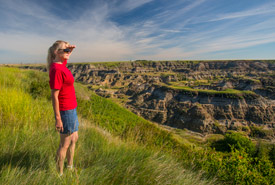
Nodwell, AB (Photo by R. Berdan)
One of my favourite things about living in Canada is getting to experience different seasons. However, my personal favourite season may not be on everyone else's list…Oscars season! As an avid film junkie, one of the most exciting times of the year is the lead-up to the Academy Awards. What makes this time even more fun is when I get to see a movie filmed in my own backyard. Canadian nature is (in my opinion) one of the most beautiful backdrops on the planet. It is no wonder that so many great films have been shot on Canadian soil.
To celebrate the 2018 Academy Awards, I have put together a list of previous Oscar-nominated films in which Canadian landscapes played a lead role.
The Revenant – 2015
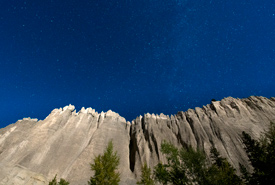
Dutch Creek Hoodoos at night (Photo by Steve Ogle)
Believe it or not, Leonardo DiCaprio getting attacked by a bear was filmed right here in Canada! Alejandro Iñárritu’s The Revenant is a great example of Canadian landscapes being showcased in film. Nominated for 12 Academy Awards and winner of three, including best cinematography, this film is a testament to Canadian nature. The lush valleys and rugged peaks of the Canadian Rockies doubled for the uncharted wilderness of Montana in the early 19th century. Many different areas of Alberta were featured in the film, including Kananaskis Country, the Bow Valley and the badlands of Drumheller. These areas are almost as famous as DiCaprio himself.
The Nature Conservancy of Canada (NCC) works to protect similar landscapes in western Canada. For example, in one scene, Tom Hardy spots a meteor, and in the background the hoodoo rock formations of Drumheller can be seen. NCC works to protect hoodoo rock formations in the Dutch Creek Hoodoos Conservation Area in BC and the Nodwell property in Alberta. Leo may have won his first Oscar for this film, but the film owes its best cinematography award to Canadian landscapes.
Arrival – 2016
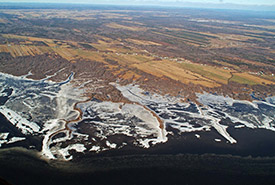
Grondines swamp, Freshwater estuary, St. Lawrence River (photo by Claude Duchaîne)
What’s more out of this world: a far-out sci-fi plot or the stunning beauty of the St. Lawrence region of Quebec? Film director Denis Villeneuve showcases both of these in his best-picture-nominated film Arrival. Quebec’s emerald hills in the Bas-Saint-Laurent act as a backdrop to this jaw-droppingly beautiful film about aliens. Nominated for eight Oscars, this film features iconic shots of the southern St. Lawrence region.
NCC works to protect important riparian areas in the St. Lawrence River area, including the Notre Dame Mountains section of the Appalachians as well as the Matapédia and Témiscouata valleys, which form natural wildlife corridors with the Gaspé Peninsula. Canadian landscapes have arrived in this film!
Capote – 2005
The bleak rural setting of Bennett Miller’s 1959 story of Truman Capote takes place in Kansas ― or so you thought. Capote was actually shot in Manitoba, with many scenes shot in downtown Winnipeg.
In one scene you can actually see Philip Seymour Hoffman run around the Manitoba Legislative Building. Other parts of the film were shot in small communities outside of Winnipeg, highlighting the beautiful landscape of the Canadian prairies. The landscapes shot in the film border on temperate grasslands — the world’s most endangered ecosystem.
NCC works to protect grasslands throughout the Manitoba and Saskatchewan prairies. Thanks to these important grasslands, Capote took home five Oscar nominations, including one for best picture.
Brokeback Mountain ‒ 2005 vs. Interstellar – 2014
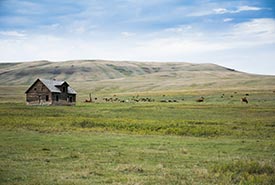
Oxley Ranch (Photo by NCC)
What do cowboys and aliens have in common? Alberta nature, apparently! Believe it or not, Ang Lee’s cowboy romance Brokeback Mountain and Christopher Nolan’s science fiction film Interstellar were both shot on the same Canadian landscape. These Academy Award-winning movies were both filmed in the Canadian heritage site of Fort Macleod. This town is located where the rolling prairies meet the foothills of the Canadian Rockies. Fort Macleod is important to both Canadian heritage and nature. Brokeback Mountain also used the Kananaskis area in Alberta to immerse audiences in a ranch setting.
Ranching and working farms are not new to NCC. The Oxley Ranch, one of Canada’s oldest working ranches, has been conserved for the long term thanks to a conservation agreement with NCC.
Titanic – 1997
One of the most famous films of all time was filmed on Canadian soil and sea. James Cameron’s film Titanic tied with two other films (Lord of the Rings and Ben Hur) for the most Academy Awards wins ever. Winning 11 awards, including best picture, Titanic was shot in and around Halifax, Nova Scotia. Many of the water scenes were shot in Nova Scotia waters, including a scene aboard the Canadian icebreaker CCGS Louis S. St-Laurent.
Aside from its ties to nature, this film is full of Canadian connections. The theme song "My Heart Will Go On" was sung by popular Canadian musician Celine Dion. James Cameron himself is also a fellow Canadian.
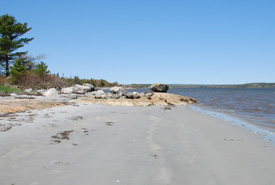
Port Joli on a clear summer day. (Photo by Matthew Betts/Canadian Museum of History)
NCC has been working to protect watersheds and wetlands areas across Canada, including many shoreline areas, such as Pugwash Estuary and Port Joli in Nova Scotia.
From coast to coast, Canadian nature has been showcased on the big screen for years. Whether you are a fan of the film industry or not, we can all take time to appreciate the beauty of Canadian nature.
Canada is a great and vast place, filled with a multitude of different landscapes. Some people will be able to see all of it in their lifetime, but for those of us who don’t have the opportunity, it’s nice to know that I can explore Canada on the big screen.


